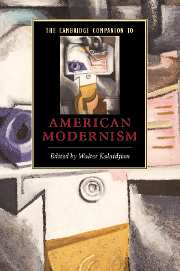1 - Nationalism and the modern American canon
Published online by Cambridge University Press: 28 May 2006
Summary
London was a Mecca for modernist writers and visual artists, with its Bloomsbury experiments in aesthetics and lifestyles, its avant-garde exhibitions and arts workshops, its audacious poetry readings, and its fiercely independent small presses and little magazines. But as Hugh Kenner has noted, none of the “masterpieces” of modernist literature (Ulysses, The Waste Land, or the first third of Ezra Pound's Cantos, for instance) were written by English writers. Moreover, the English language and English literature itself had become decentered: Kenner went on to argue that “by midcentury . . . English was the language not only of the Three Provinces but also of several masterpieces best located in a supranational movement called International Modernism.” The literature that he espoused - primarily the work of T. S. Eliot, Ezra Pound, Wyndham Lewis, James Joyce, William Carlos Williams, William Butler Yeats, Marianne Moore, and Samuel Beckett - all, in Kenner's view, belonged to this “supranational movement.” Indeed, modernism has often been conceptualized as a stridently international phenomenon across art and literature.
But if we accept such a vision of modernism as international, what could the phrase “American modernism” possibly mean? Does it refer to a specific subset of international modernism (that is, work produced by American modernists), or to a different kind of writing altogether? In the late nineteenth and early twentieth centuries, many American writers (modernist or not) were grappling with the “American-ness” of their own writing, seeking to understand what could define their literature as a national literature and not simply as a provincial footnote to English literature. American literary nationalism proved a powerful cultural force even as modernists began to engage with international avant-gardism. The national (or international) identity of modernism was by no means as lucid then as later scholarly assessments, including Kenner’s, might suggest.
- Type
- Chapter
- Information
- The Cambridge Companion to American Modernism , pp. 12 - 36Publisher: Cambridge University PressPrint publication year: 2005
- 10
- Cited by

